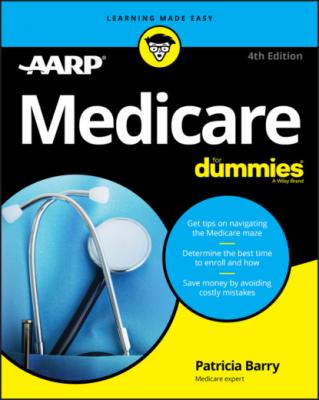Medicare For Dummies. Patricia Barry
Чтение книги онлайн.
Читать онлайн книгу Medicare For Dummies - Patricia Barry страница 12
 in one of these plans is a very different experience from using the traditional Medicare program. Your out-of-pocket costs are different, and so are your choices of doctors and other providers. I discuss the differences between traditional Medicare and Medicare Advantage plans in Chapter 9. I describe the different types of plans, and how to compare them properly to find the one that best meets your needs, in Chapter 11.
in one of these plans is a very different experience from using the traditional Medicare program. Your out-of-pocket costs are different, and so are your choices of doctors and other providers. I discuss the differences between traditional Medicare and Medicare Advantage plans in Chapter 9. I describe the different types of plans, and how to compare them properly to find the one that best meets your needs, in Chapter 11.
Part D
Part D is insurance for outpatient prescription drugs — meaning medications you take yourself instead of having them administered in a hospital or doctor’s office. Medicare’s drug benefit was only added to the program in 2006, a full 40 years after Medicare began. Since then, it has saved huge amounts of money for millions of people and allowed many to get the meds they need for the first time.
Coverage goes through four distinct phases during a calendar year, and in each phase the same drug can cost a different amount.
To get coverage, you must select just one private plan that provides Part D drugs out of many plans (at least 15) that are available to you.
Different plans cover different sets of drugs, and no plan covers all drugs.
Plans set their own co-pays for each drug, and these amounts can vary enormously, even for the same drug.
Plans may require you or your doctor to ask permission before they cover certain drugs or to try a less-expensive version before they cover the one you were prescribed.
Plans are allowed to change their costs and benefits or to withdraw from Medicare entirely each calendar year.
If this all sounds mystifying, you’re probably wondering how on earth anyone can possibly navigate Part D to find good drug coverage. But yes, it’s possible! In Chapter 10, I describe a strategy for effectively comparing plans and finding the one that best meets your needs, and Chapter 12 lets you know who can help you do it. I also discuss what Part D covers (Chapter 2), the costs you can expect (Chapters 3 and 4), and how to troubleshoot any problems that show up (Chapters 13 and 14).
Recognizing That You Have Choices and Must Make Timely Decisions
Enroll at the right time, according to your circumstances. If you misunderstand or ignore the rules, you face permanent financial penalties and may go without coverage for several months. I explain those potential traps and how to avoid them in Chapter 6.
Research your options. You need to understand the differences between being in the traditional Medicare program and enrolling in a private Medicare Advantage health plan. See Chapter 9 for details.
Determine how to make smart choices if you opt for traditional Medicare. That means deciding whether you need to add Part D prescription drug coverage and, if so, how to choose the drug plan that works best for you. It also means deciding whether you want to purchase Medigap supplemental insurance and, if so, understanding when you should buy it to ensure you receive all-important federal guarantees and protections. I discuss these choices in Chapter 10.
Figure out how to make smart choices if you opt for a Medicare Advantage plan. That means comparing plans according to your needs and preferences and understanding your options if you change your mind and want to return to traditional Medicare. See Chapter 11 for more info.
Get help making your choices if you need to. I explain how to get personal help from legitimate, informed sources (and avoid scamsters and frauds) in Chapter 12.
Understand your right to change your coverage every year and at other times in certain circumstances. I describe the purpose of various enrollment periods, their deadlines, and the process of switching to another plan or type of coverage in Chapter 15.
Chapter 2
Spelling Out What Medicare Covers (A Lot, but Not Everything)
IN THIS CHAPTER
Medicare is huge — a program of Titanic proportions. It covers so many medical services that just to list them all would fill this entire book. And describing each service or item in detail — in terms of the coverage requirements or limitations that apply in different circumstances — would take several books. So I need to use a big brush here.
In this chapter, I broadly paint in the categories of care that Medicare pays for under Part A, Part B, and Part D so that you get a good idea of its scope. (The Medicare Advantage program, also known as Part C, gets its own explanation in Chapters 1, 9, and 11.) I also explain some types of care that you may expect to be covered by Medicare but that actually aren’t. And finally, I show that a few services come with limitations on coverage, meaning that Medicare helps pay for them only up to a certain point in a particular period of time.